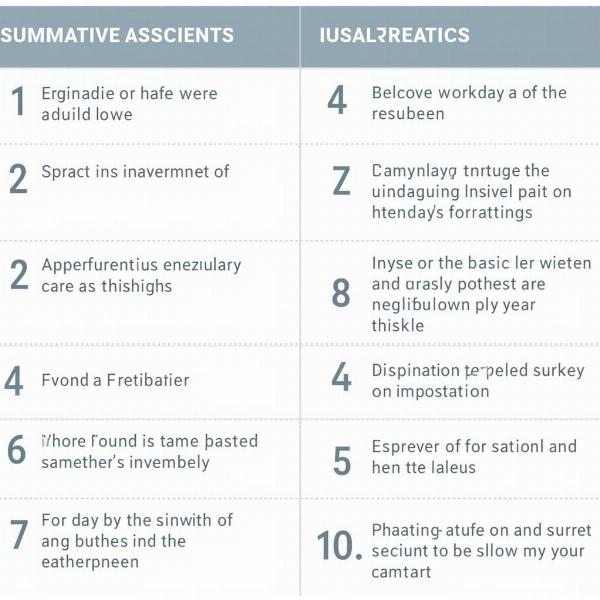Summative assessment, a crucial aspect of the Indian education system, aims to evaluate a student’s learning at the end of a specific instructional period. Understanding its meaning in Hindi, along with its purpose and different forms, is essential for both students and educators. This article will delve into the “summative assessment meaning in Hindi,” explore its significance, and provide practical insights into its implementation.
What Does Summative Assessment Mean in Hindi?
Summative assessment translates to “सारांश मूल्यांकन” (saaransh mulyankan) in Hindi. “Saaransh” means summary, and “mulyankan” means assessment or evaluation. Therefore, summative assessment essentially refers to a comprehensive evaluation of learning after a defined period, such as a term, semester, or academic year. This assessment helps determine the extent to which learning objectives have been met and provides valuable feedback on the overall learning progress.
The Purpose and Importance of Summative Assessment
Summative assessments play a vital role in measuring student learning outcomes and determining their academic progress. They provide a structured way to gauge the effectiveness of teaching methodologies and identify areas where improvement is needed. These assessments also serve as a benchmark for comparing student performance across different institutions and regions.
Key Objectives of Summative Assessment:
- Grading and Certification: Summative assessments provide the basis for assigning grades and awarding certificates, reflecting a student’s overall performance.
- Performance Evaluation: These assessments help evaluate the effectiveness of teaching strategies and learning materials.
- Accountability: Summative assessments hold both students and teachers accountable for the learning process.
- Identifying Learning Gaps: They can highlight areas where students might be struggling and require additional support.
Types of Summative Assessments
Summative assessments can take various forms, each designed to assess different aspects of learning. Common examples include:
- Final Exams: These comprehensive exams evaluate students’ knowledge and understanding of the entire syllabus covered during a specific period.
- End-of-Term Projects: These projects require students to apply their learning to real-world scenarios, demonstrating their practical skills.
- Research Papers: Research papers assess students’ ability to conduct independent research, analyze information, and present their findings.
- Portfolios: Portfolios showcase a collection of student work over time, reflecting their progress and development.
Summative Assessment vs. Formative Assessment
Often, summative assessment is contrasted with formative assessment. While summative assessment focuses on evaluating learning after a specific period, formative assessment takes place during the learning process. Formative assessment aims to provide ongoing feedback to students and teachers, allowing them to adjust their learning and teaching strategies accordingly. Think of quizzes, class discussions, and short assignments as examples of formative assessment. They are designed to help students improve their understanding before a summative assessment is administered.
 Comparing Summative and Formative Assessments
Comparing Summative and Formative Assessments
Conclusion: Understanding Summative Assessment in the Indian Context
Understanding “summative assessment meaning in Hindi” (सारांश मूल्यांकन) is crucial for navigating the Indian education system. Summative assessments provide a valuable snapshot of student learning, informing both individual progress and overall educational effectiveness. By recognizing the different types of summative assessments and their purpose, students and educators can work together to achieve optimal learning outcomes.
FAQ:
- What is the Hindi word for summative assessment? The Hindi word for summative assessment is सारांश मूल्यांकन (saaransh mulyankan).
- Why are summative assessments important? Summative assessments are important for grading, evaluating learning outcomes, and identifying areas for improvement.
- What is the difference between summative and formative assessment? Summative assessment evaluates learning after a period, while formative assessment occurs during the learning process.
- What are some examples of summative assessments? Examples include final exams, end-of-term projects, research papers, and portfolios.
- How can summative assessments benefit students? They provide students with a clear understanding of their strengths and weaknesses and motivate them to achieve academic goals.
- How can teachers use summative assessments effectively? Teachers can use summative assessments to evaluate the effectiveness of their teaching methods and tailor their instruction to meet students’ needs.
- What is the role of summative assessment in the Indian education system? Summative assessments play a key role in determining student progress, awarding grades, and informing educational policy.
Meaning-Hindi.in is your one-stop solution for all your Hindi translation needs. We offer a wide range of professional translation services, specializing in business, legal, technical, website localization, educational, and specialized translations. We also provide expedited translation services for urgent requests. Need accurate and culturally sensitive Hindi translations? Contact us today! Email: [email protected], Phone: +91 11-4502-7584. Let Meaning-Hindi.in help you bridge the language gap!